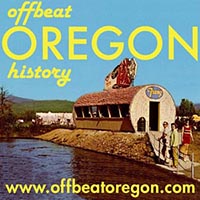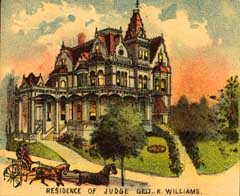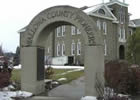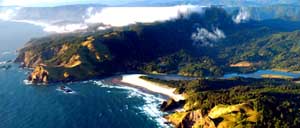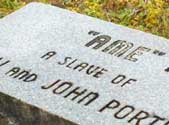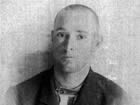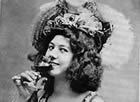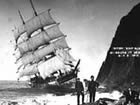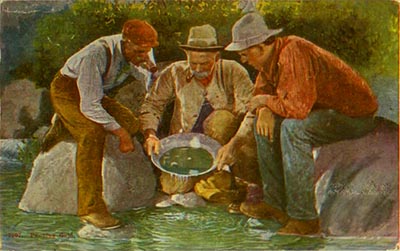The Lost Ledge
A short story about a Southern Oregon gold miner who lost everything that was important to him one day — and then got the most important part of it back just in time. (Presented as a work of fiction in Pacific Monthly Magazine, December 1898)
By Laura Miller — December 1898
The old man stood gazing stupidly into his mining pan. He had been standing so in the shallow stream for full 16 minutes, shifting the sands from side to side. There was a gleam of “colors” and little golden nuggets mixed with the mud, sand and water in the flaring, rusted rim.
In a laurel on the mountainside a quail piped shrilly. The man started as it from a dream, and one toilworn hand fumbled about until the nuggets lay in the calloused palm. They would have meant so much to him once! Now he had lost what gold could not bring back.
The warm sun of Southern Oregon poured its rays down on the granite hills, and the hills cast the heat back fiercely. There was no movement, no sound to break the stillness of nature; there was no human being to break the loneliness of the man.
He turned from the stream and walked slowly through the brush until he came to a hole, dug deep in the ground, the prospect hole where he had struck “pay dirt”; then with a sudden fierceness he took the shovel and attacked the heap of gravel and fresh earth at his side. The afternoon dragged on, and when the sun went down the place was level again.
The old man looked carefully about him. To the right was a tall pine; he blazed the trunk. On the left he marked a laurel; south to the stream it was forty steps; north to the hill, two hundred steps. Then, shouldering pick, shovel and pan, he plodded down the slope as the twilight gathered, a pathetic figure in the silent hills.
Fifteen years came and went, and the clatter of civilization broke the stillness of the centuries.
The owner of the Gouge Company mine sat in his oftlce talking to a stranger. The mineowner was big and good-natured and hearty. Life had scattered nuggets in his pathway, and consequently he and life were very good friends.
The stranger was an old, gray-haired man, with a story written in the drooping lines of face and figure, a story of struggle and failure, of disappointed faith and lost ideals. And yet the eyes belied this story. It was as if hope, slumbering for years, had waked in the worn-out body.
The mine owner leaned forward in an interested way: “You say you know of a rich ledge near here, Mr. Ives?” he asked. “Now, if you will tell me about it we might make you a proposition worth considering.”
“Well,” said the stranger, slowly. “It was this way: I came out to Oregon from the states in ‘56, and went to prospecting. I don’t know how it happened, but I came here into the mountains and worked around. One day I struck it rich. I filled up the hole and left, and this is the first time I’ve been back. Of course, your mine has been opened up since, and things are a good deal changed, but I’m certain that I can find that place. And it’s rich gravel, Mr. Andrews.”
“What I can’t see,” said the mineowner, “is why you didn’t work it yourself.” And he looked at Ives doubtfully.
“I didn’t have money myself; besides, the gold didn’t make much difference to me then,” said Ives.
There was a moment’s silence, during which Mr. Andrews tried to weigh the probability of the story from a purely business standpoint, while Mr. Ives sat staring absently at the opposite wall. Instead of the narrow office he saw a courtroom filled with people. The lawyers, judge and jury were like figures in a mist, but the face of the youthful prisoner was white and clear-cut, and very much like his own.
Mr. Andrews’ voice called him from the past. “You are sure you can ftnd the place?” he said.
“I remember the marks I cut on the trees. It must be somewhere within five miles of here back from the canyon.”
“You will find the canyon pretty much torn up and worked below. You see a man named Jones prospected here, and I bought the mine from him fifteen years ago. We’ve worked straight along the creek ever since. There have been lots of prospectors around in these mountains, too, so you may have a hard time of it.
“Well! Mr. Ives,” said Andrews, rising; “maybe you would like to go down to the mine with me. We are busy just now; almost finished piping, and are scraping bedrock. And,” he added, as they stepped into the yard, “as I said before, if you find the place and it’s rich we will make you an offer for it.”
As far away as one could see on the ridge was a narrow, light strip, lost sometimes in the gorges, but always reappearing on the points. It was the mining ditch which came from the mountains twenty miles away. The ditch grew broader as it neared the canyon, until one caught the gleam of water where it was swallowed by the great, black pipe, reaching far down into the mine below. From the front of the house a rocky slope led gown to the stream, and across the stream were granite hills, through whose gaps the road wound to the outer world.
The two men took a path following the creek. After a few minutes’ walk they came to an open apace on the edge of a bluff. The mine spread wide before them one hundred feet below. The giant boomed with a deafening roar as the water shot against the cliffs, turned to spray and ran down in muddy rivulets. A long line of sluiceboxes stretched through the canyon. Where the line stopped two Chinamen were working over the “tailings.” Beyond the water ran in a tumbling, yellow stream along the mined-out gorge. The black pipe crawled from the mountainside down to feed the giant. Around a bend to the right the workmen were scraping bedrock. Some of them threw dirt into the sluice boxes; others dug in the crevices of the rock with curious, spoon-shaped scrapers, then swept the crevices with brushes and washed them with water.
“Well, what do you think of it, Mr. Ives?” asked the mineowner, with evident pride.
“It is a good mine,” said Ives, “but I can show you what will make as good a one. You are busy, so I think I’ll hunt the place up now.”
He turned and started back into the hills.
“He’s brisk for such an old man,” thought the mineowner. “I can’t understand why he didn’t work that ledge. He looks honest, but there is something the matter somewhere.”
It was late in the evening when Peter Ives came back to the mineowner’s house. A merry group sung college songs on the vine-hung porch to the thrum of a banjo. The light streamed through the open doorway, and as Ives came along the walk Mrs. Andrews noticed that he looked tired and very old.
Mr. Andrews called out: “Well! What luck?”
Peter Ives leaned heavily on his cane. “I didn’t find the place,” he said, and there was a weariness in his voice.
“You’ll know all the better where to look tomorrow,” said the mineowner, in a comforting tone.
The next day the old man wandered from dawn to dark among the hills. Yawning prospect boles mocked him. Some time during those fifteen years a spring freshet had torn through the gaps, and the course of the stream was changed. He could find no trees that were marked, and as he turned from a spreading laurel the thought came with a suddenness that was terrifying — perhaps the spot was east of the stream instead of west. His frame trembled so that he could not stand, and he sat on a log thinking, thinking, trying to remember, until it seemed that he was not himself.
Somewhere he had heard of an old broken-hearted man who had been happy once, but a great blow came to him and broke his faith in man. He found a rich ledge, but he hated the gold, for gold had caused his sorrow, and it gave him a savage delight to leave it burled in the earth. Yet, for some reason, he marked the spot. After years of waiting for death a letter came, and, with it, hope. But when he wanted the gold he could not find lt. It was strange the man should forget, Peter Ives thought.
Something snapped suddenly in his head, and he remembered that he was the man. He arose and began the search again. He came back at nightfall, worn and disheartened, only to look agai the next day. The mineowner’s family were kind to the old man, who was wearing away his strength wandering through the hills, and when he came back night after night, they did not ask him if he had success. The gray, pinched look in his face, and the added stoop to the bowed figure were answer enough. So, for a month, old Peter Ives sought for the lost ledge in the hills, in the morning always hopeful, at night always dejected.
Then he went back to his lonely cabin on the toll road.
The stage came rattling down the steep grade of the
California toll road. The driver slowed the horses to a walk, and, pointing with his whip, said to the passenger by his side: “Curious slide on the mountain yonder. I never look at it without thinking what old Peter Ives said about it.”
The passenger looked the deep ravine to where a great, rounding mountain stood. Its sides were covered with low brush, but running from the top, halfway down to the base, was a great, irregular slide.
The driver continued: “The slide came there one night in the spring — red soil, you see, makes it look so curious — and the day I saw it I says to Ives — he lives down in the canyon here — ‘Seen that curious-looking slide?’ He was standing in his door, and he turned his eyes to the mountains, and says: ‘It’s like some big crab’s claw reaching down to pinch the life out of me.’”
The stage swayed around the curves, down the shelf-like road on the cliff, clattered over the bridge and drew up at the door of a rude cabin. The driver clambered from his seat. “Guess I’ll say howdy to Ives,” he said.
But inside the door be paused, for the old man sat smiling over a much-worn letter, and the smile was not of earth. Very reverently the driver stooped and read:
“Dear Father: Twenty years in prison have made a man of me. May God forgive me all I have made you suffer for my crime. Yesterday the governor pardoned me out. Father, if you can forgive me, I will come to you to begin again.”

